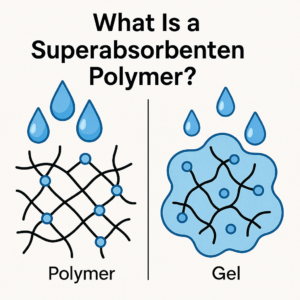A polimero superassorbente (SAP)—also known as a superabsorbent material (SAM)—is a network of cross-linked polymer chains capable of absorbing and retaining up to 500 times its own weight in water or aqueous solutions. These materials transform from a dry, granular or powdered form into a hydrated gel that releases moisture slowly under pressure. First pioneered by the U.S. Department of Agriculture in the 1960s for soil-moisture conservation, SAPs now underpin a vast range of consumer, agricultural, medical, and industrial products.

A Brief History of SAP Development
-
1960s: USDA researchers develop the first SAP by grafting acrylonitrile onto starch. Intended to improve water retention in sandy soils, this starch-based SAP absorbed roughly 60–100× its weight.
-
1970s: Advances in petrochemical processing yield acrylic-based polymers with dramatically higher absorbency.
-
1978: First commercial use of acrylic SAP in sanitary napkins, offering superior fluid management and odor control.
-
1982: Introduction of SAP in baby diapers revolutionizes disposable absorbent hygiene, reducing bulk and increasing dryness.
-
Today: Global SAP production exceeds 3 million tonnes per year, with over 85% used in personal-care hygiene (diapers, pads, incontinence products) and the remainder in agriculture, packaging, medical, and industrial applications.
The Chemistry of Superabsorbent Polymers
-
Monomer Neutralization
-
Acrylic acid (CH₂=CH–COOH) is partially neutralized (~70–80%) with a base—usually sodium hydroxide (NaOH) or potassium hydroxide (KOH)—to yield sodium or potassium acrylate.
-
Partial neutralization controls the ionic strength and swelling behavior:
mathematicaCH₂=CH-COOH + NaOH → CH₂=CH-COO⁻ Na⁺ + H₂O
-
-
Cross-Linking
-
A small fraction (0.01–0.2 wt%) of a multi-functional agent—such as trimethylolpropane triacrylate (TMPTA) or tetraallyl ethoxy ethane—is added to create covalent bridges between polymer chains.
-
Cross-links prevent dissolution, maintain gel integrity, and modulate mechanical strength.
-
-
Network Formation
-
Upon polymerization, a three-dimensional network of gel “pockets” forms.
-
These pockets act like semi-permeable membranes: water enters via osmosis, but large polymer strands cannot escape.
-
Manufacturing Techniques
| Method | Key Features |
|---|---|
| Gel Polymerization | • Monomer, base, cross-linker & UV initiator sprayed on moving belt • UV light triggers in situ polymerization • Forms a “wet cake,” then ground, dried, and optionally surface-treated |
| Suspension Polymerization | • Monomer/base/cross-linker dispersed in organic solvent with surfactant • Agitation controls bead size • Beads filtered, solvent recycled, dried, surface-modified if needed |
| Solution Polymerization | • Monomer, base & cross-linker dissolved in inert solvent with initiator • Forms soluble polymer • Applied as liquid coating to fibers or substrates, then dried into laminate or airlaid core |
Surface Cross-Linking
After initial drying, an additional treatment with surface cross-linkers can be applied to:
-
Increase gel strength under load
-
Accelerate absorption rate (liquid acquisition)
-
Improve permeability (fluid passage through the swollen gel)
Key Performance Characteristics
-
Free Swell Capacity
-
Measured as grams of water absorbed per gram of SAP in pure water (commonly 300–500 g/g).
-
-
Absorption Under Load (AUL)
-
Capacity retained when a defined pressure (e.g., 0.3 psi) is applied; critical for diapers and incontinence pads.
-
-
Rate of Absorption
-
Speed at which SAP hydrates; influenced by surface cross-link density and particle size.
-
-
Gel Strength & Permeability
-
Resistance to deformation and ability to allow fluid to migrate through the swollen gel.
-
-
Water Retention Over Time
-
Measure of how long the SAP retains absorbed water under varying environmental conditions.
-
-
Particle Size Distribution
-
Typical mesh sizes range from 20–100 mesh (~150–850 µm); affects blending uniformity with soil or non-woven fibers.
-
-
Wicking & Deodorization
-
Specialized treatments can improve capillary fluid transport and incorporate odor-adsorbing additives.
-
Global Production Capacity by Major Manufacturers
| Manufacturer | Paese | Annual Capacity (tons) |
|---|---|---|
| Nippon Shokubai | Giappone | 700,000 |
| BASF | Germania | 600,000 |
| Sumitomo Seika Chemicals | Giappone | 450,000 |
| Evonik | Germania | 500,000 |
| Sanyo Chemical / SDP Global | Giappone | 420,000 |
| Yixing Danson | Cina | 420,000 |
| LG Chem | Corea del Sud | 400,000 |
| Taiwan Plastics | Taiwan | 200,000 |
| Satellite Science & Technology | Cina | 200,000 |
| Quan Zhou Technology | Cina | 140,000 |
| GELSAP | Cina | 80,000 |
Applicazioni in tutti i settori
Personal Care & Medical
-
Baby Diapers & Incontinence Products:
High AUL and rapid absorption keep skin dry under pressure. -
Feminine Hygiene Pads:
Thin, ultra-absorbent cores prevent leaks and control odor. -
Wound Dressings & Medical Pads:
Manage exudate in surgical and chronic wounds.
Agriculture & Horticulture
-
Ritenzione dell'umidità del suolo:
Blend 0.1–0.5 wt% SAP into potting mixes to reduce irrigation by up to 50%. -
Seed Coatings & Germination:
Enhance seed-to-soil contact and provide sustained moisture for young roots. -
Fertilizer Blends:
Slow-release of water-soluble nutrients directly at the root zone.
Industrial & Environmental
-
Oil-Water Separation & Dewatering:
Capture aqueous wastes; immobilize oils in cleanup operations. -
Biohazard Fluid Capture:
Immobilize blood or bodily fluids in laboratory or field spills. -
Packaging Pads for Meat & Produce:
Lock in exudates to extend shelf life and prevent sogginess.
Specialty Uses
-
Artificial Snow:
For film, theater, and decorative applications. -
Cement Modifiers:
Improve freeze-thaw resistance in concrete mixes. -
Flood-Control Sacks:
Rapidly swell to block water ingress in emergency situations. -
Ice Packs & Cooling Gel Packs:
Create re-usable, non-toxic cooling pads.
Gelok’s SAP Expertise
Gelok leverages sodium polyacrylate SAPs to custom-engineer absorbent cores for diverse applications:
-
Ultra-Thin Laminates:
SAP particles hydrogen-bonded between two tissue layers for minimal profiles. -
Airlaid-Style Cores:
Blends of SAP and cellulose fibers air-laid and bonded for high capacity. -
Surface-Treated Cores:
Polyester or non-woven substrates combined with adhesives and SAP for specialized water-retention rolls.
All Gelok products are manufactured under an ISO 9001:2015-certified Quality Management System, ensuring consistency, safety, and performance.
Domande frequenti
-
Do SAPs dissolve in water?
No—the cross-linked network swells into a gel but does not dissolve or break apart. -
How do salts affect absorption?
High salt concentrations (e.g., urine, blood) reduce osmotic drive, cutting capacity from ~300–500 g/g in pure water down to ~20–50 g/g under saline conditions. -
Are SAPs biodegradable or compostable?
Conventional acrylic SAPs are not readily biodegradable. Research into starch-grafted and bio-based alternatives continues to address landfill concerns. -
Can SAPs harm plants or animals?
When fully neutralized (especially potassium-based grades for soil), SAPs are non-toxic. Avoid inhaling dust and contact with eyes; use proper PPE during handling. -
Is sodium polyacrylate considered a plastic?
Yes—it is a synthetic polymer derived from petrochemical feedstocks. -
Can I flush SAPs down the drain?
No—swelling within pipes can cause blockages and damage wastewater systems. -
Do SAPs absorb oils or organic solvents?
No—SAPs are designed for aqueous fluids and will not uptake non-polar liquids. -
Is it safe to ingest SAPs?
Absolutely not. Ingestion can lead to internal swelling, dehydration, and obstruction.
Choosing and Using the Right SAP
-
Capacity vs. Strength:
– Low cross-link density = higher free-swell capacity
– High cross-link density = stronger gel under load (better retention) -
Particle Size:
– Finer granules (100–200 µm) blend seamlessly into potting mixes and non-wovens
– Coarser beads (500–850 µm) ideal for topdressing and soil incorporation -
Surface Treatment:
– Increases absorption speed, gel strength, and permeability for demanding hygiene and medical applications -
Neutralization Type:
– Sodium‐based SAPs excel in hygiene; potassium‐based grades prevent soil salinization in agriculture
By understanding the full lifecycle—from monomer chemistry and manufacturing techniques to performance characteristics and final application—you can select and apply superabsorbent polymers to achieve optimal fluid management in any project, whether it’s keeping a baby dry, growing drought-resilient crops, or cleaning up industrial spills.

